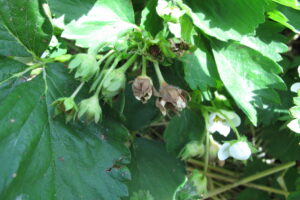One of our earliest harvested fruit crops in Indiana are strawberries. This is good and bad news, depending upon the occurrence of a late spring freeze. Strawberries are very susceptible to these freezes for a number of reasons: Air temperature at ground level is often colder than the reported low temperature, low spots may be even colder, and rural locations, lacking the heat island we see in bigger cities are even colder than the temperatures reported in most ‘local’ news outlets
Our early and fluctuating spring weather presents a problem for growers. Like other fruit crops, strawberry flowers are susceptible to different temperature extremes at different times. They are most susceptible to freeze damage at open flower. The critical temperature for flower buds as they emerge from the crown is ~10°F. That critical value rises to ~22°F when flower buds have elongated but blossoms are tightly closed. When the flowers petals become visible (popcorn), the critical temperature is 26°F . Open flowers can tolerate freezes down too ~30°. Developing green fruit better tolerates cold temperatures than buds or blossoms, to ~ 28°F.
To determine if your flower buds suffered frost or freeze damage (Fig.1), cut through the buds; cold-damaged flower buds/blossoms will have a black center.
***
Monitor fields for disease. Scout fields when dry (afternoon, evening) to reduce the risk of pathogen spread. Scout fields weekly for infected plants, especially when conditions are warm and wet. If conditions are wet, eliminate (or minimize) overhead irrigation
Implement sanitation. Reduce the inoculum of disease-causing fungi or bacteria by removing infected leaves and fruit. If disease levels begin to run high, infection foci (‘hot spots’) need to be eradicated (remove and destroy). This includes any and all infected plants, in addition to plants within ~ 5 ft. radius of the infected area. Harvest all known areas of infection last to minimize the spread of the disease.
Early and regular sprays. Fungicide applications work best when applied early and often, sometimes as often as 7-10 days depending on disease pressure. See the Midwest Fruit Pest Management Guide at https://ag.purdue.edu/hla/Hort/Documents/ID-465.pdf or the draft of the new version of the guide that follows. The label is the law: Follow all pesticide labels
Fungicide applications protect plants from infection, and subsequent disease build-up that spreads to additional plants. The choice of fungicide is based upon:
- The plant growth stage (phenology), and
- The weather forecast.
If the forecast predicts multiple days of rain around or during bloom, begin applications of captan to protect the crop, adding a FRAC 7, FRAC 11 or FRAC 7+11 fungicide if needed. Save that one application of iprodione (Meteor/Rovral) to protect against botrytis until bloom. Follow up with captan or another fungicide that is effective against both botrytis anthracnose. Keep in mind that freeze damage will make damaged tissues more susceptible to infection by the botrytis and anthracnose fungi, and may warrant earlier use of a Pristine, Merivon, or Luna Sansation (FRAC7+11) fungicide, to protect fruit, and more importantly, the crown of the plant. Use the new schedule to see if any additional fungicides are needed to protect against other potential disease problems. One upshot of the FRAC 7+11 fungicides is their broad range of activity against a number of strawberry pathogens.
Root rot Management
If your field has a history of Phytophthora diagnoses, then an application of Ridomil Gold SL may be necessary. Phytopthora root and crown rots, along with leather rot, thrive in wet conditions. Up to 3 applications can be used per year (last column of table), so it is important properly time applications for maximum effectiveness. This means one application in the spring after the ground thaws but before first bloom, and a second application in the fall. For supplemental control of leather rot, an application may be made at fruit set.
Understand the proper timing of fungicide applications is critical to strawberry disease management. Unfortunately, most of the diseases that impact strawberry develop symptoms when fruit is ripening, The time to protect against infection occurred even before the first flower opened, through bloom. Hopefully, the new layout of the guide will provide clearer instruction on what to apply and when to apply it. Please send any question or comments to janna@purdue.edu
